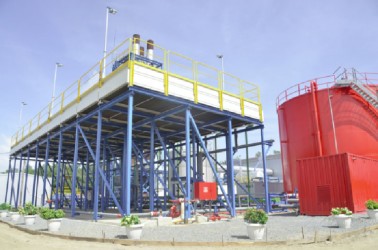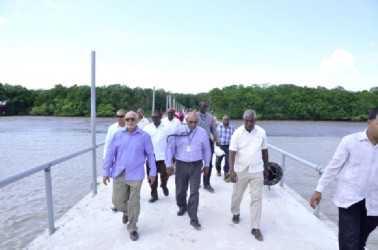With the commissioning of a US$35M 26 MW power plant by the Guyana Power & Light Inc. (GPL) at Vreed-en-Hoop, West Coast Demerara, the delivery of electricity would be significantly improved and the facility has state-of-the-art flood protection.
Residents in Region Three would benefit greatly from this new facility as it allows the entire area to be self-sufficient, GPL says
Through an interconnecting system from the Kingston Power Plant that runs through the Demerara River via a submarine cable, consumers can now enjoy 106 MW of power, from the 80 MW that they were being served.
Chief Executive Officer (CEO) of GPL, Bharrat Dindyal told this newspaper that the cable is being protected by “heavy steel armouring around it.” He confirmed that the overall project amounted to US$35M.

The development of the facility started over two years ago with GPL and Wartsila consummating a turnkey contract in September 2012.
It consists of three Wartsila 20V32 diesel generating sets together with mechanical and electrical auxiliaries, and will be fired using heavy fuel oil (HFO).
The HFO which proved to be 52% cheaper than diesel has resulted in the company saving almost 90%.
In his remarks, GPL’s chairman, Winston Brassington noted that the 106 MW of power in Demerara is operated by Wartsila under an operating and maintenance contract.
The investment in the engines has helped GPL to substantially lower its cost and benefit from reduced unit generating cost, improved engine efficiency, improvement in reliability and the ability to transmit and distribute power about 200 km from source.
The power company recorded 127,000 new customers from 2005 and by the end of 2014 the figure had increased to 177,000.
He urged customers to practise energy conservation and to desist from stealing electricity. He also told them to report persons who are engaged in such practice.
The project comes alongside the recently developed infrastructure programme which provided for a transmission line all the way to Berbice, a link of the Demerara-Berbice system and a number of new substations.
The new system can now send power all the way to Molsen Creek, Corentyne in the East and Parika, East Bank Essequibo in the West. The generation system is now supplying 10 MW of power to Berbice through the new link.

Technical overview
In the technical overview of the project, Dindyal said that the completion of the foundation for the 26 MW plant faced a series of challenges in terms of the soil being very poor.
As such, the company had to use 900 piles, 72 ft. in length instead of the regular 65 ft. and experienced difficulties sourcing them. Despite the setback, the project which started two years ago was still successfully completed.
Those piles were needed as the equipment had started to sink when it came off the dam. Sand which was dumped to prevent sinking started disappearing and geotextile material had to be imported.
Wartsila’s civil design contractor had also insisted that further testing be done to supplement the geotechnical report which was submitted to them the previous year.
During September 2012, GPL engaged an engineering company to undertake the geotechnical analysis of the site with assistance and guidance provided by Wartsila’s sub-contractor for the civil design. The final geotechnical report was received on September 28 and provided to Wartsila.
Dynamic pile testing was done at eight test piles by a company from St. Lucia and the data supported that from a number of protection piles that had already been driven for the foundation therefore confirming the findings for the geotechnical report.
The project was also delayed by flooding and two heavy-duty pumps have since been installed to prevent a recurrence. The plant is said to have “a flood control system capable of handling the highest level of rainfall.”

Criteria
Outlining the technical overview of the project, Dindyal said the evaluation of options to locate a new power plant in the Demerara-Berbice interconnected system had to satisfy a few important criteria, including access to marine transport for fuel, proximity to the transmission system and the ability to access load centres via both transmission lines and distribution feeders.
He said the site, located close to the stelling, not only meets those important criteria but also allows the entire West Demerara to be self-sufficient in the generating capacity during times of maintenance when the transmission link with East Demerara has to be isolated.
The plant also consists of heat recovery boilers, switch gears to accommodate the plant’s interconnection, new feeders and the further expansion of the plant, bulk storage tanks for heavy fuel oils, light fuel oil and lubricating oil, a modern and fully equipped workshop.
It also has a multi-layered firefighting system capable of handling both electrical and fuel fires and a generator to allow for the plant to start independently, a sophisticated control and monitoring system covering the entire facility, noise mitigation measures, a water processing and separation systems and multi-layered corrosion protection.
Other facilities that were contracted to other parties included the expansion of the 69 kb substation to connect the plant to the Berbice grid and the construction of an interconnecting pipeline to deliver heavy fuel oil to the facility by marine tanker.
Dindyal said that “since the Garden of Eden (East Bank Demerara) power plant was constructed in the mid-1970s as a generating facility that included new berthing facilities, it should be mentioned that the new power plant has been designed to accommodate two additional megawatts generating units.”
On December 4, 2012 the National Procurement & Tender Administration Board awarded a supervision contract for the civil works and on December 11, it was awarded to Samaroo’s Investment and it subsequently withdrew.
In February 2013, a new contract was awarded to Correia & Correia and in the same month Wartsila submitted the foundation design.
In September 2013 the main shipment of equipment consisting of three generators and power plant equipment arrived in Georgetown. And after weeks of delay the generators were transported from Parika to the site.
A stone shortage created further delays in completing the foundation for the bulk storage tanks and the second tank was completed in August and handed over for assembly to start.
In August 2014 the first machine was started using diesel.
By November the substation expansion was completed and the pre-commissioning test of the power plant was also completed and the plant was connected to the national grid and was ready to commence load testing.
After a series of tests and the correction of minor defects the contractual performance test started on November 25. The performance tests were successfully completed in December and the plant was placed into commercial operation.
Since August last year, GPL executed an operations and maintenance agreement with Wartsila for the facility.




